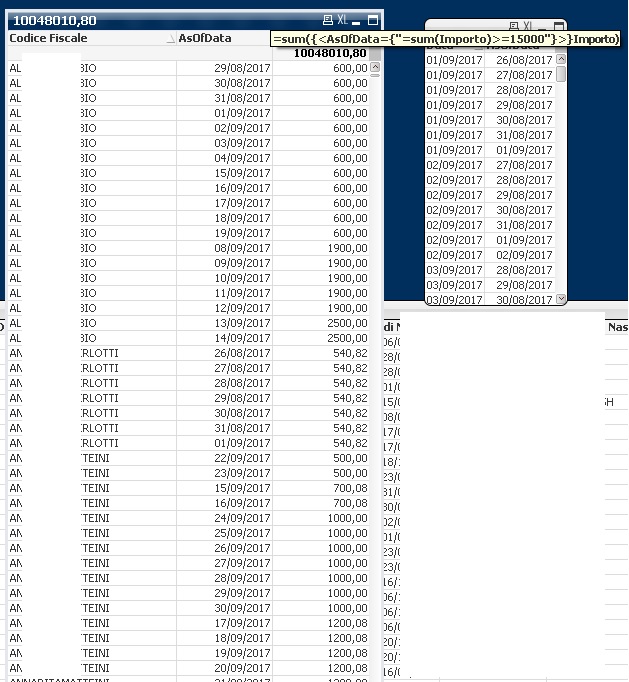Unlock a world of possibilities! Login now and discover the exclusive benefits awaiting you.
- Qlik Community
- :
- All Forums
- :
- QlikView App Dev
- :
- Re: Help with count (with conditions)
- Subscribe to RSS Feed
- Mark Topic as New
- Mark Topic as Read
- Float this Topic for Current User
- Bookmark
- Subscribe
- Mute
- Printer Friendly Page
- Mark as New
- Bookmark
- Subscribe
- Mute
- Subscribe to RSS Feed
- Permalink
- Report Inappropriate Content
Help with count (with conditions)
Hello everyone,
I have a dataset (an inch more complex than this but hopefully this will serve) like this:
| Data | TicketID | PersonID | Amount |
| 01/09/2017 | 1 | BGXXXXX1A | 4 |
| 05/09/2017 | 2 | BGXXXXX1A | 7 |
| 05/09/2017 | 3 | BGXXXXX1A | 2 |
| 06/09/2017 | 4 | BGXXXXX1A | 1 |
| 06/09/2017 | 5 | BGXXXXX1A | 10 |
| 07/09/2017 | 6 | BGXXXXX1A | 11 |
| 08/09/2017 | 7 | BGXXXXX1A | 12 |
| 11/09/2017 | 8 | BGXXXXX1A | 1 |
| 15/09/2017 | 9 | BGXXXXX1A | 1 |
I need to count for each Data the number of the distinct TicketID that I can find in the very next 7 days but only if the sum of the amount exceeds 25.
I'm expecting this output:
| Data | ID | Count | SumAmount |
| 01/09/2017 | BGXXXXX1A | 6 | 35 |
| 05/09/2017 | BGXXXXX1A | 11 | 44 |
| 06/09/2017 | BGXXXXX1A | 5 | 35 |
| 07/09/2017 | BGXXXXX1A | 3 | 24 |
| 08/09/2017 | BGXXXXX1A | 3 | 14 |
[...]
Last 2 rows should not appear for their amount is less than 25.
Can't really find a way to achieve my result.
Could anyone of you please help me out?
Thank you!
- Mark as New
- Bookmark
- Subscribe
- Mute
- Subscribe to RSS Feed
- Permalink
- Report Inappropriate Content
There is, but this is probably the best way to handle your situation... others are going to be very slow on the front end... if you would like... I can guide you there as well... but look here before you think of going there
- Mark as New
- Bookmark
- Subscribe
- Mute
- Subscribe to RSS Feed
- Permalink
- Report Inappropriate Content
I tried to create the AsOfTable in my datamodel, however I'm getting the sum of the amounts for every record and not only those whose sum is larger than "x".
I'm in a daze ![]()
- Mark as New
- Bookmark
- Subscribe
- Mute
- Subscribe to RSS Feed
- Permalink
- Report Inappropriate Content
Did you look at the expression that I have used?
- Mark as New
- Bookmark
- Subscribe
- Mute
- Subscribe to RSS Feed
- Permalink
- Report Inappropriate Content
Sure. I noticed that in your example, AsOfData takes the place of Data. In my application this doesn't happen.
- Mark as New
- Bookmark
- Subscribe
- Mute
- Subscribe to RSS Feed
- Permalink
- Report Inappropriate Content
But did you not create a AsOfDate in your AsOfTable?
- Mark as New
- Bookmark
- Subscribe
- Mute
- Subscribe to RSS Feed
- Permalink
- Report Inappropriate Content
This is what I get after creating the AsOfTable
| Data | AsOfData |
| 01/09/2017 | 26/08/2017 |
| 01/09/2017 | 27/08/2017 |
| 01/09/2017 | 28/08/2017 |
| 01/09/2017 | 29/08/2017 |
| 01/09/2017 | 30/08/2017 |
| 01/09/2017 | 31/08/2017 |
| 01/09/2017 | 01/09/2017 |
| 02/09/2017 | 27/08/2017 |
| 02/09/2017 | 28/08/2017 |
| 02/09/2017 | 29/08/2017 |
| 02/09/2017 | 30/08/2017 |
| 02/09/2017 | 31/08/2017 |
| 02/09/2017 | 01/09/2017 |
| 02/09/2017 | 02/09/2017 |
| 03/09/2017 | 28/08/2017 |
| 03/09/2017 | 29/08/2017 |
[...]
- Mark as New
- Bookmark
- Subscribe
- Mute
- Subscribe to RSS Feed
- Permalink
- Report Inappropriate Content
Right, so why can't you use this as your expression?
=Sum({<AsOfData = {"=Sum(Amount) > 25"}>}Amount)
- Mark as New
- Bookmark
- Subscribe
- Mute
- Subscribe to RSS Feed
- Permalink
- Report Inappropriate Content
In my application, using that expression, results in showing every single record (x7 times) 
- Mark as New
- Bookmark
- Subscribe
- Mute
- Subscribe to RSS Feed
- Permalink
- Report Inappropriate Content
What happens if you don't have AsOfData as your dimension?
- Mark as New
- Bookmark
- Subscribe
- Mute
- Subscribe to RSS Feed
- Permalink
- Report Inappropriate Content
It sums the amounts correctly but shows values lower than 15000 too